NAMBARZ®: The number card game
Ayham Alata
I. COMPOSITION OF THE DECK

The game is made up of a deck of 92 playing cards (figure 1):
A. 40 cards marked just with Numbers. B. 40 cards marked with numbers plus pictures. C. 3 wildcards that allow a change of number. D. 3 wildcards that allow a change of picture. E. 3 wildcards that allow a change of number or picture. F. 3 wildcards that allow a replay
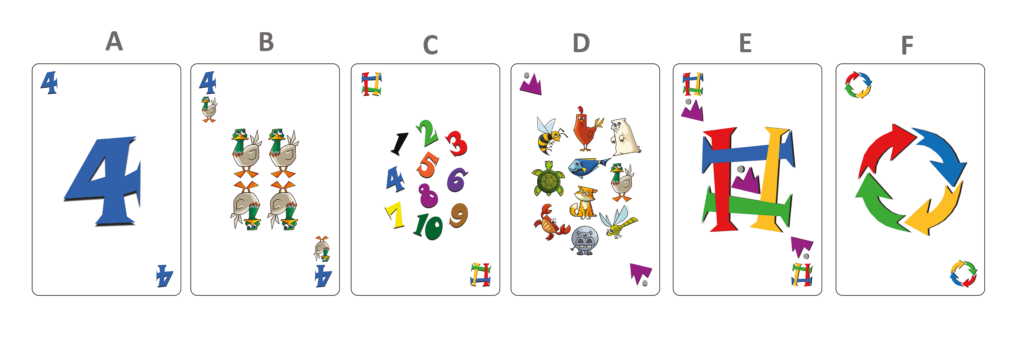
II. THE OBJECT OF THE GAME

After shuffling the cards well, 7 cards are dealt to each player. The remaining cards stay in a pile. To begin play, the dealer turns the top card face up in the remaining pile and this card must not be a wildcard. The player sitting on the dealer’s left takes the first turn. Each player’s goal is to be the first player or team to discard all of his or her cards.
If a player does not have any regular cards or appropriate wildcards that will allow play, the player must take a card from the central pile. If this card is playable, it can be directly played or played in combination with other cards or added to the player’s hand. In that case, the player says, « I pass, » and the next player has a turn. If the central stack of cards is exhausted, all discarded cards will form a new pile.
III. PLAYING METHODS
There are two alternative means of discarding cards: by pairs of matching cards or through the use of mathematical operations.
1. By matching pairs

The upturned top card in the central card pile can be covered by a player’s card that has a matching number, or a card with a matching picture.
For example, the card « 3 bees » may be covered by any of the following types of cards (figure 2):
- an identical « 3 bees » card
- another card with the number 3, such as a plain 3 card or « 3 hippopotami »
- or another card bearing the same picture but a different number, such as « 8 bees »

On the other hand, the card with just plain 3 can only be covered by any of the following types of cards (figure 3):
- an identical plain 3 card
- another card with the same number, such as « 3 hippopotami » or « 3 bees »
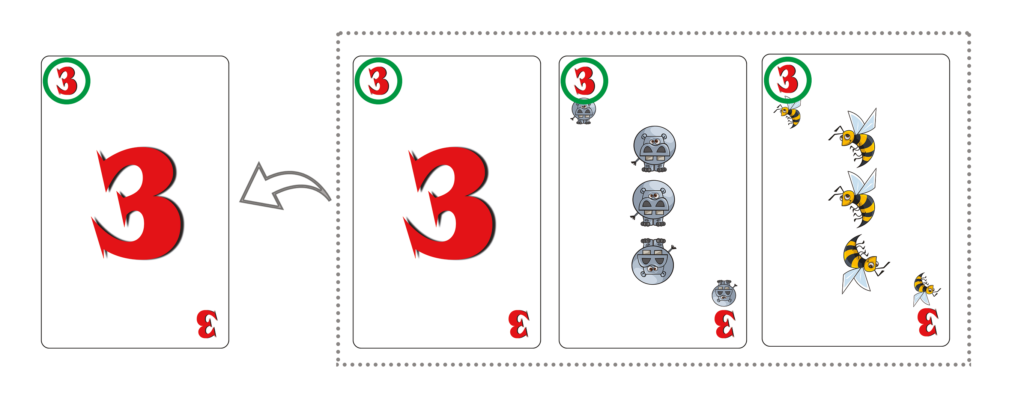

The cards displaying numbers plus pictures offer more matching options than do the cards with numbers alone.
2. By mathematical operations

It is also possible to eliminate two or more cards at once by performing mathematical calculations that result in an answer which corresponds to the number required during that turn. All of the cards that are involved in the operation are to be discarded in the order in which they were used while doing the math.
It is possible to include multiple calculations within one turn, using addition, subtraction, multiplication and/or division, using whichever order and number of cards is necessary to obtain the desired result.

It is always permitted and more desirable to use math, even when the player has the required matching card in his or her hand, as long as that matching card is not used in the calculation, as will be explained later.
The rules involving the use of math are simple:
- The order of
the mathematical operations is decided by the player. Therefore, the answer to
the first operation involving cards one and two can then be used in combination
with a third card to calculate a new answer, and that answer can then be combined
with a fourth card in a new operation, and so on, as is possible. - Cards being
used in mathematical operations must be of the same type: either all plain
number cards or all number plus picture cards. It does not matter, however,
what type of card the card is which is to be covered and which the final
calculation must match.
For example: the « 3 bees » card or the 3 alone card may be covered by several different combinations of cards:
A. combination using plain number cards (figure 4) may use: cards bearing the numbers 1 and2 using the formula 1+2 or cards 10, 4 and 2 using (10 – 4)/2. (In the latter example, the player puts down the card with the 10, then the 4 and then the 2.) The next player must then cover the 2 card.
B. Combination using number plus picture cards (figure 5) may use: cards « 7 fish » and « 4 hens » using 7-4 or cards « 10 bears », « 1 dragonfly », « 1 turtle » and « 9 ducks » by using the formula: 10+1+1-9.
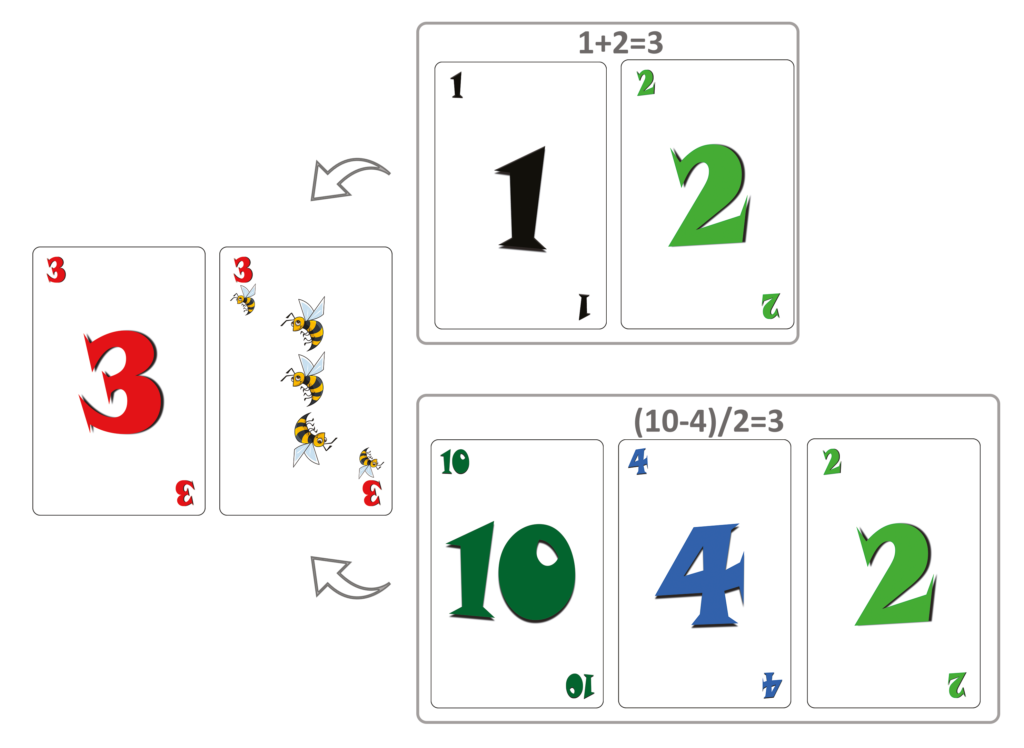
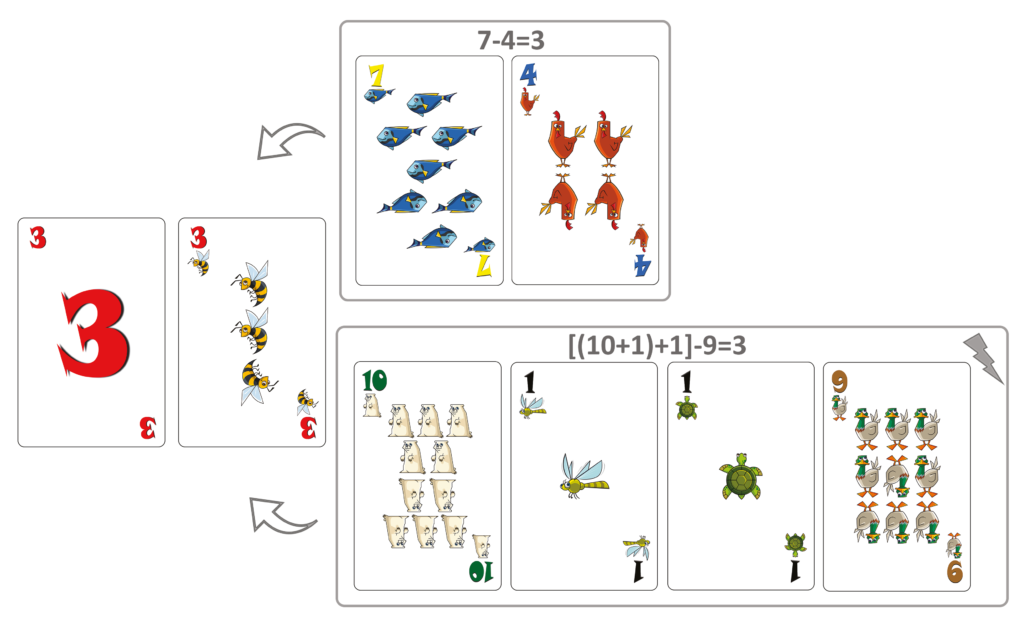
The player must, at all times, be sure that the mathematical result is obtained using a minimum number of cards.

For example, to cover a « 3 bees » card or a 3 alone card, the player is not allowed to lay down plain 6, 5, 2 and 10 cards using the math formula : 6+5+2-10=3, because the same result could be achieved with a 6 card and a 2 card, calculating 6/2=3 (figure 6). Thus, the player must play cards 6 and 2, and hold onto cards 5 and 10.
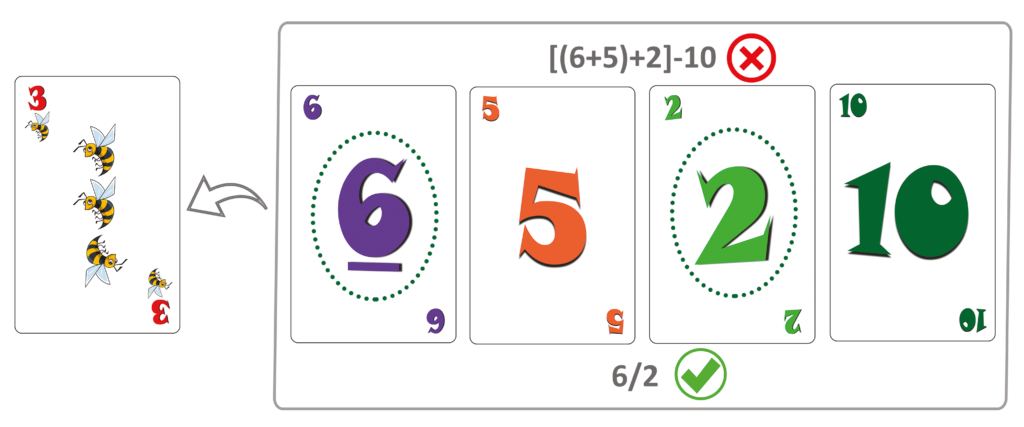
In addition, a card which matches the card to be covered cannot be used in a mathematical operation because it is meant to be played by itself.

For example, to cover a « 3 bees » card, a player cannot lay down a plain 9 card and a plain 3 card using 9/3 because the plain 3 card already shares the same number as the card to be matched. It is also not possible to use an « 8 bees » card and a « 5 cats » card using 8-5, as the « 8 bees » card already matches the design on the card to be covered. In these two examples, the player must play the matching card by itself and hold onto the other cards (figure 7).
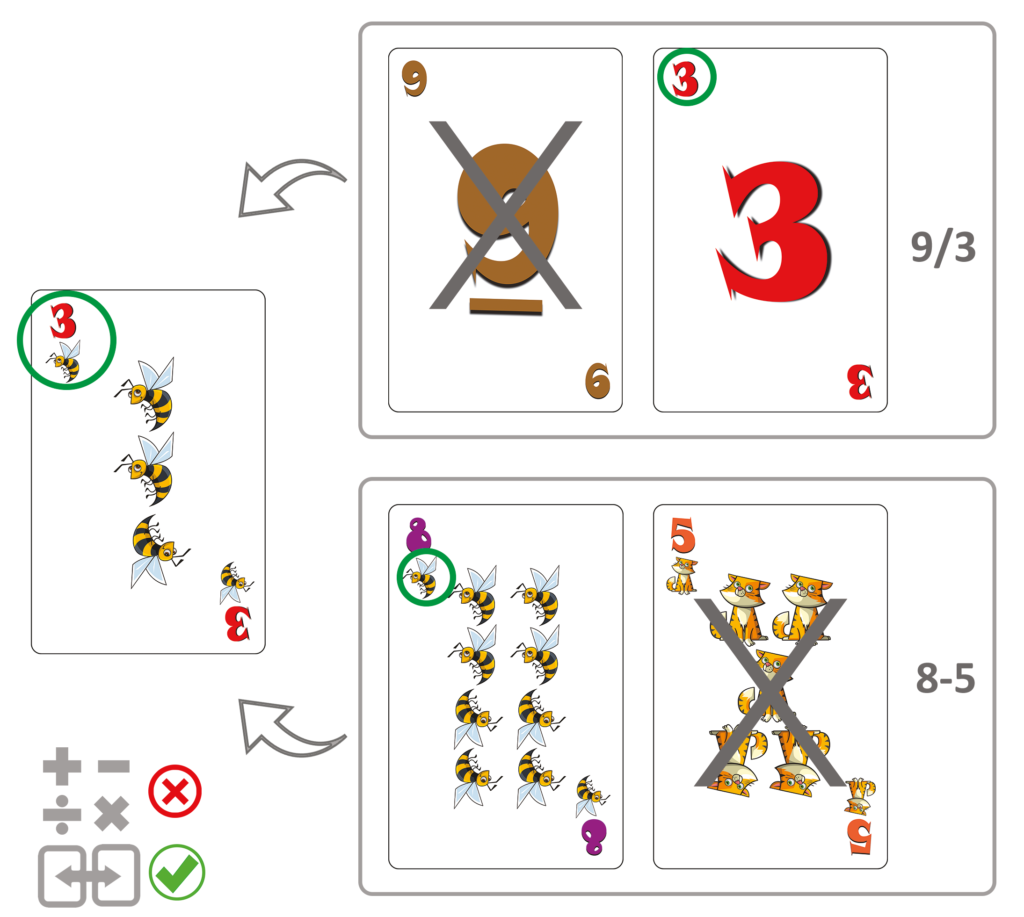
IV. THE USE OF WILDCARDS

- The wildcard that allows a change of number (figure 1-C) can only cover a card that displays a number alone. It cannot cover a number plus picture card. In using this wildcard, a player has the right to choose and replay another card, as long as it is a number only card (figure 8).
- The wildcard that allows a change of picture (figure 1-D) can only cover a card that displays a number plus picture. It cannot cover a number alone card. In playing this card, a player has the right to choose and replay another card, as long as it is a number plus picture card (figure 8).
- The wildcard that allows a change of number OR picture (figure 1-E) may cover either type of card (number alone, or number plus picture). The player then has the right to choose and replay another card of either type (figure 8).
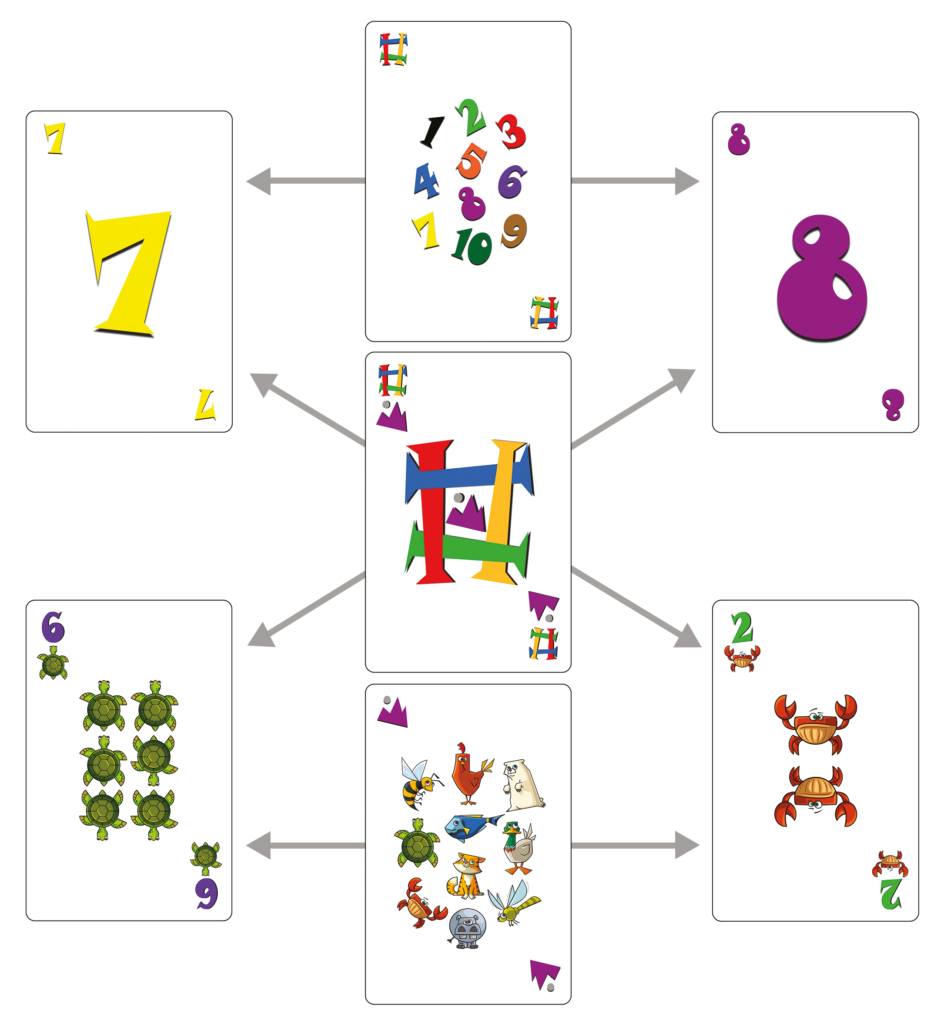

It is also possible to play one of the three types of wildcards without replaying another card (for example, when using a wildcard as the final card discarded from a hand or to allow a teammate to choose and play a card). In this situation, the next player would lay down a plain number card, or a number plus picture card, depending on the type of wildcard that had just been used.
The rule that a result must be obtained by using a minimum number of cards also applies to the use of wildcards. Therefore, a player must not play a matching card after the use of a wildcard, as a matching card must be played alone. In addition, it is not permissible to play two wildcards in a row, a rule that only applies to the first 3 types of wildcards.
- After taking a turn, a player may throw down a replay wildcard (figure 1-F) if there is another card or other cards in his or her hand that could be discarded. In effect, this wildcard lets a player take an additional turn and eliminate one new matching card or several cards employing mathematical calculations. Either way, this extra turn must correspond to the last card laid down before the wildcard was played. This wildcard can also be played even if the player lacks any appropriate cards for a replay (or if this is the player’s only remaining card). If this occurs, the player picks a card from the central pile and plays it alone or in combination with other cards, if possible, and if not, retains it in his or her hand. In addition, it is permissible to play this wildcard even without having already taken a first part of this turn (due to a lack of appropriate cards), as this will allow the player to pick a card from the pile in the hope that it will improve his or her hand.

This wildcard is very important because it creates the possibility of eliminating several cards in one turn (6 or more, if the player completes a master stroke). For example, to cover a number 1 card, a player could put down : « 9 hens, » « 6 dragonflies » and « 3 hippopotami, » using the math formula (9-6)/3, then laying down the replay wildcard and finally using up other cards that can cover the card that preceded the wildcard, in this case « 3 hippopotami. » To cover this card the player might use a 10 number only card, a 6 number only card, and a 1 number only card, by calculating: 10-6-1 (figure 9).
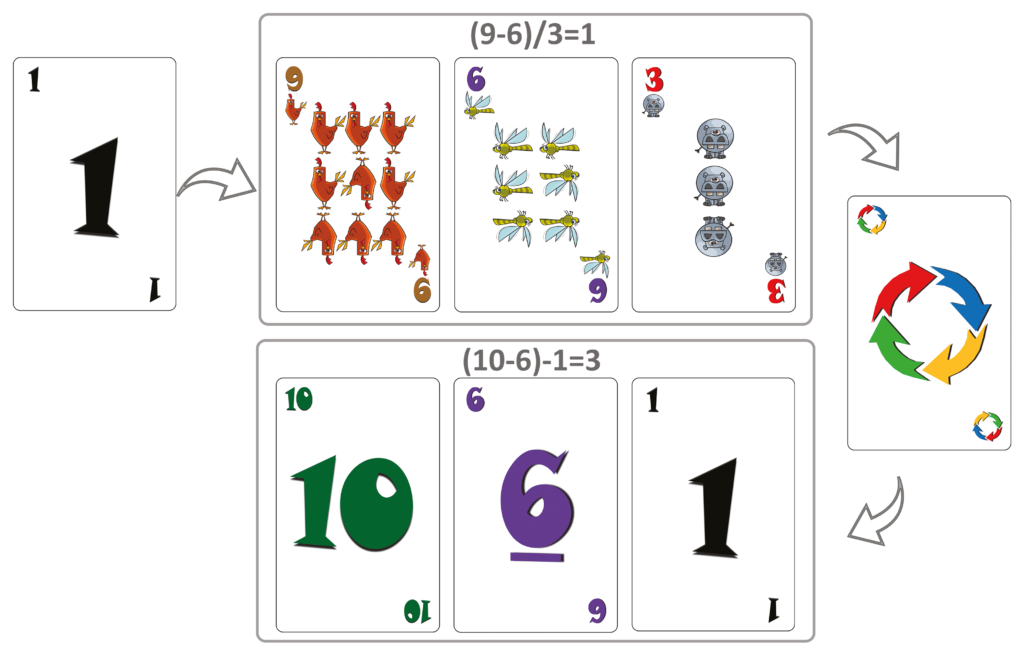
V. PENALTIES

A player is penalized and must pick up 3 cards from the central pile in the following cases:
- If the minimum number of cards possible is not used in performing a calculation (as already seen).
- If a card which matches the card to be covered is used in a mathematical operation (also as already seen).
- If different types of cards (number alone, and number plus picture cards) are both used in one turn involving math. In that case the player must take back the cards just played and the next player takes a turn.
- If the result of the mathematical operations is incorrectly done, in that it does not match the number on the pile card that must be covered. If the player can alter the math to obtain the correct answer using all of the same cards as in the first try (that is, without changing the cards used), he or she may play those cards. If not, the player must hold onto those cards and the next player takes a turn.
- When a player uses a wildcard incorrectly.

Once a card leaves the player’s hand, it is considered to have been played. The player may not take it back and try to play a different card.
VI. OPTIONS OF A GAME
Players can choose between :
- a short game: by opting for all players to each play a single round,
- a typical length game: by playing 3 rounds,
- or a longer game: by extending play to 5 rounds.
A single round of play typically runs from 15 to 30 minutes when 6 people are playing the game.
VII. NUMBER AND AGE OF PLAYERS
NAMBARZ can be played by anywhere from 2 to 12 players at once, either as individuals or in teams. It is suitable for children starting at age 8, the age by which simple arithmetic operations have been learned (addition, subtraction, multiplication and division).
It can be even be played by quite young children, as long as the mathematical operations used are restricted to those that the child has mastered. For example, when playing the game with a child, at first limit the use of math to addition and subtraction, and later expand it to include multiplication and division.
VIII. COMPLETING A ROUND OF PLAY

A round ends when a certain number of players have used up all of their cards, depending on the total number of players participating in the game.
- For 2 to 5
players: when all but one remaining player have used up all of their cards. - For 6 to 12
players: when 5 players have used up all of their cards.
The player who accumulates the most points in one round starts play in the next round.
IX. PLAYING AS INDIVIDUAL OR IN TEAMS

It is possible to play NAMBARZ® as individual players and, in that case, each player earns his or her own points independently. It is also possible, however, for players to participate as teams of 2 or 3 or more players per team. Then each player has a hand of 7 cards and each player takes his or her turn. The only constraint is that the members of a single team take their turns consecutively, one after the other, before play passes to the members of the next team, and so on. This allows team members to play single cards or multiple cards in a way that, to the extent that it is feasible, will maximize the next member of the same team’s chances of playing well. Teammates can consult with each other to decide how each team member should play his or her turn to the best advantage. Each team’s goal is to receive good rankings for its members by earning the most points possible, regardless of which team member finishes the hand first. At the end of a round, all of the points received by each member of a single team are tallied to obtain the team’s total score.

If the only players still holding cards in their hands all belong to the same team, the round is over and the team members receive their points based on their situations when the round ended.
X. CALCULATING THE RESULTS

At the end of each round, players receive points according to their rankings: the first to finish the round receives 40 points, the second gets 32 points, the third is given 25 points, the fourth obtains 19 points and the fifth garners 14 points. In addition, any « master stroke » points achieved are then added to the final scores.

When the game is being played by 2 to 5 players, points are given to every player (including the person who has not discarded his or her entire hand), according to each player’s ranking. On the other hand, if 6 to 12 people are playing, points are only distributed to the 5 players who have used up all of their cards (as the round ends when 5 players have completed their hands).

THE MASTER STROKE: A player makes a « master stroke » and gains 7 extra points if he or she uses up 4 cards in one mathematical play (for example: 10+1+1-9=3, as in figure 5). If someone eliminates 5 cards at once (for example: 8+8-1-1-9=5), that would be considered a « super master stroke » and would be rewarded with 14 supplemental points. Beyond 5 cards, 7 more bonus points are awarded for each additional card used in a single play involving math. (For example: if 6 cards are used, 21 bonus points are received.) Warning: Such extra points are only awarded when the rules involving the use of math are respected.
At the end of the game, each player’s total points are tallied. If the game has been played by teams of participants, every team member’s points are included in calculating a team’s total score. The player or team with the highest score wins the game and the others are ranked according to their final results.

If the game ends in a tie, the joint winners (whether individual players or teams) play an extra round to determine the game’s ultimate winner.
For calculating points, a score sheet can be downloaded here, or a plain sheet of paper can be used.
To learn how to fill in this sheet, please see figure 10, which contains an example for a game involving 12 players.
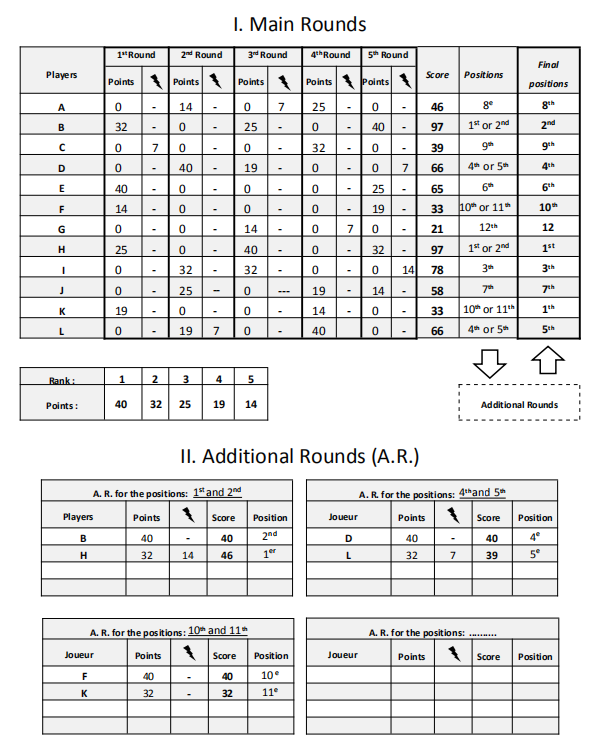
XI. VARIANT FORMS OF THE GAME

- Beginners: Play using all of the available wildcards.
- Experienced players: Play using only 8 wildcards (2 of each type).
- Top level players: Play using only 4 wildcards (1 of each type).
